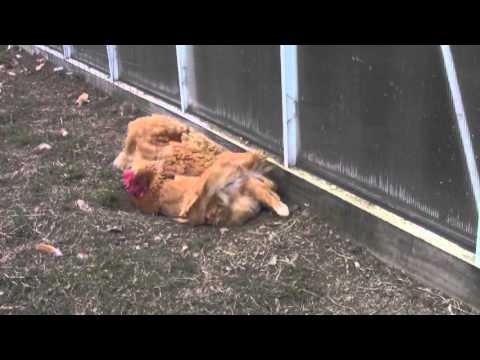Chickens love to take dust baths. This helps to keep their feathers clean and in good shape, but more importantly, it helps to keep them free of mites and lice. Mites and lice can be serious pests of your flock. If chickens are left untreated in an outbreak, the results can be a general weakening, lower egg production, loss of appetite, lethargy, and possibly death. Your chickens should be active all daythey are not moving much, there may be something wrong. If it's not time to molt, but they are picking their feathers out, and their feathers appear dull and dirty, especially near the base and vent, you might have a problem with mites or lice. The first thing to do is to determine what type of pest you have.
Identifying the pests
There are three types of mites that most effect poultry:
Chicken or Red Mites:
Identification
- Active in warm climates in summer
- Feed at night on the chickens, hide in the roosting bars and coop during the day
- Look like tiny black or red specks on the chickens
- Control with thorough cleaning of coop, nest, and roosting bars, followed by a miticide dusting
Remedy
- Chicken mites are fairly easy to control, because you don't have to treat the chickens themselves, which is nice, because they don't like to be sprayed, cleaned, or dusted.
Northern Fowl Mites:
Identification
- Active in cool climates in winter
- Causes scabby skin and dark feathers around vent
- May see tiny specks crawling on birds or eggs during the day
Remedy
- Dust birds and nests with miticide immediately
Scaly leg mites:
Identification
- Burrow under the chicken leg scales
- Causes scales to stick out, and chicken to walk stiff
Remedy
- Control by applying a mixture of one part kerosene to two parts linseed oil, and coat legs daily with Vaseline daily for 2 weeks
Don’t forget poultry lice:
Identification
- Chewing, small wingless insect that will feed on dry scales and feathers
- Chickens will pull out their own feathers to stop the irritation
- Result is feathers look dull and rough
- You can see straw colored bug moving on chicken’s skin
- You will also see scabby dirty areas around vent and tail, and masses of louse eggs
Remedy
- Control with a delousing product approved for chickens, applied to coop, nests, roosts, and chickens. Also, make sure to remove old feathers.
- This will need to be redone 7 days later, then 7 days later again. This will insure newly hatched lice are taken care of as well.
Products for Miticide Control
Sevin Dust
Sevin dust is effective in killing existing mites and can be applied safely to the coop and birds, but must be reapplied for any eggs that hatch. Warning, this is a strong insecticide and miticide.
Poultry Protector
Poultry protector is a natural alternative if you do not want to use chemicals. Potassium sorbate is the active ingredient. It will not kill the mites, but it will inhibit their reproduction. This requires frequent application to birds and coop.
Diatomaceous Earth (DE)
DE is a simple and cost effective solution for treating and preventing mites, lice, fleas and ticks. Sprinkle it on your chickens or provide it in the dust bath area for added protection.
***As with any chemicals, please read label for instructions on safe application
Prevention
Monitoring your flock for any of the symptoms and acting quickly if an infestation occurs is a good way to manage these pests. I've had good luck with keeping the pests off my flock by moving my coop and runs every week. I do this with coops on wheels, paddocks, and electronet fencing. If you have a stationary coop and run, pest pressures tend to build over time.
//www.youtube.com/embed/KDQNornJPtA
This is a companion discussion topic for the original entry at https://peakprosperity.com/how-to-control-mites-and-lice-on-chickens/
